Instructional Series
This site will be closing soon as its content has moved to Tāhūrangi.
2024 titles are available on Tāhūrangi. Use the filters to find specific series.
Find Literacy resources at Tāhūrangi - Literacy.
Welcome to the English medium literacy instructional series teaching and learning resources for years 1 to 8.
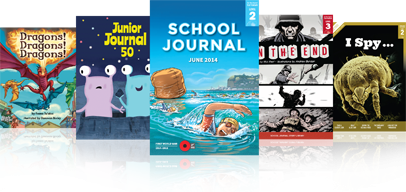
- Gold
- Purple
- Magenta
- Yellow
- 3
- 4
- 2
- 1
- 6
- 4
- 5
- 8
- 7
- 3
- 1
- English
- Social Sciences
- Science
- Health and Physical Education
- Technology
- Mathematics and Statistics
- The Arts
- Non-fiction
- Fiction
- None
- Nature of science
- Geometry and Measurement
- Living world
- Planet Earth and beyond
- Nature of technology
- Physical world
- Number and Algebra
- Statistics
- Technological knowledge
- Material world
- Technological practice
- Engage with science
- Gather and interpret data
- Interpret representations
- Use evidence
- Articles
- Stories
- Poems
Search results
166 items - Showing 31 - 40
-
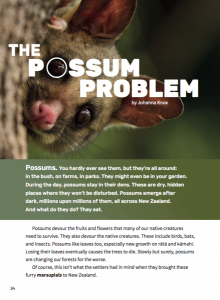
The Possum Problem
by Johanna Knox
illustrated by Adele Jackson
"Possums. You hardly ever see them, but they’re all around: in the bush, on farms, in parks. They might even be in your garden. During the day, possums stay in their dens. These are dry, hidden places where they won’t be disturbed. Possums emerge after dark, millions upon millions of them, all across New Zealand. And what do they do? They eat."
-
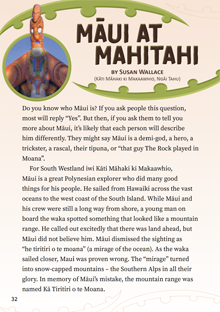
Māui at Mahitahi
by Susan Wallace
Do you know who Māui is? If you ask people this question, most will reply “Yes”. But then, if you ask them to tell you more about Māui, it’s likely that each person will describe him differently. They might say Māui is a demi-god, a hero, a trickster, a rascal, their tipuna, or “that guy The Rock played in Moana”. For South Westland iwi Kāti Māhaki ki Makaawhio, Māui is a great Polynesian explorer who did many good things for his people.
-
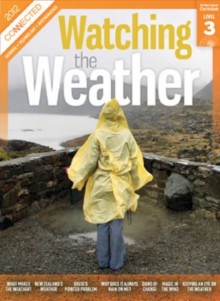
New Zealand's Weather
by Eric Brenstrum
This article outlines the global influences on the weather. It explores how oceans, continents, and icecaps affect the way air moves, heats, and cools. It then reinforces the concepts explained in “What Makes the Weather” by applying them to the context of weather in the South Pacific and particularly in New Zealand.
-

The Waka Te Arawa in Aotearoa
by Mataia Keepa (Te Arawa, Ngāti Maniapoto, Ngāti Rārua)
This infographic illustrates some of the landing sites of the waka Te Arawa in Aotearoa New Zealand. It outlines stories associated with each site and other places that were named by people on the waka. It also describes objects and taonga that were brought on the waka such as kūmara and taininihi.
-
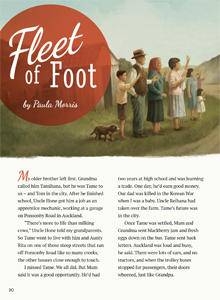
Fleet of Foot
by Paula Morris; illustrations by Andrew Burdan
The movement of Māori to the cities in the 1950s and 1960s was one of the most significant movements of people in our recent history. Paula Morris has used stories from her whānau as a basis for “Fleet of Foot”, a work of fiction that sits alongside “Kei Te Tāone Nui”, an article in the same journal that also explores the topic of Māori urbanisation. The text has links to the Aotearoa New Zealand’s histories curriculum.
-
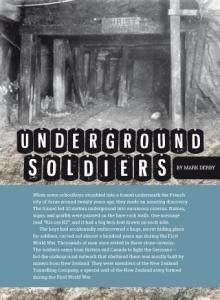
Underground Soldiers
by Ashleigh Young
In a straightforward report (supported with period photographs, a map, and a detailed diagram), this article shows the huge risks that were taken by New Zealand tunnellers during the First World War. The job of the tunnellers was to attack German positions from underground and so reduce the risks to Allied soldiers in no-man’s land. The tunnels also provided areas where wounded soldiers could be treated.
-
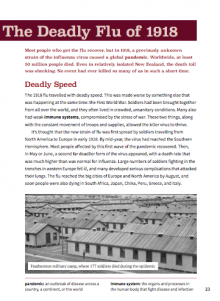
Pandemic: The Deadly Flu of 1918
by Renata Hopkins
Most students are aware of New Zealand’s participation in the First World War, but few will know of the flu pandemic that swept across the world in its aftermath. In New Zealand, the epidemic took over nine thousand lives in under two months – an appalling number, especially if compared with the eighteen thousand soldiers whose lives were lost to the war. This article conveys the horror of the event while imparting factual information about how the virus spread and how the government and communities tried to deal with it.
-
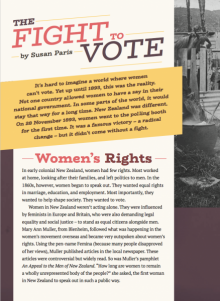
The Fight to Vote
by Susan Paris
"It's hard to imagine a world where women can't vote. Yet up until 1893, this was the reality. Not one country allowed women to have a say in their national government. In some parts of the world, it would stay that way for a long time. New Zealand was different. On 28 November 1893, women went to the polling booth for the first time. It was a famous victory – a radical change – but it didn't come without a fight."
-
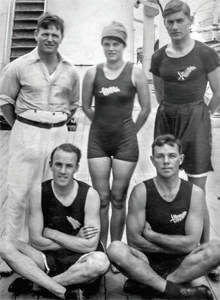
Our First Olympians
by Bill Nagelkerke
“Faster, higher, stronger ...” The Olympic Games have been a source of international interest and entertainment since the late nineteenth century. This article provides information on some of our earliest Olympians, with a particular focus on the four athletes who attended the 1920 Summer Olympics in Antwerp, Belgium. It was the first year that Aotearoa New Zealand had sent an independent national team to the games, and despite facing additional challenges of distance and expense, all four athletes made the finals with one winning a bronze medal. The final paragraph of the article extols the benefits of aiming high and working hard to achieve a goal.
-
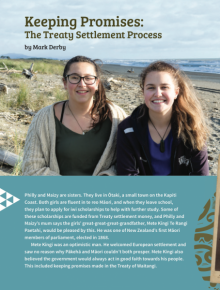
Keeping Promises: The Treaty Settlement Process
by Mark Derby
This article provides an accessible introduction to the Treaty settlement process. The content covers events from 1840, when the Treaty of Waitangi was signed, through to the present day. The material is organised in to sections with brief, clear headings. It also includes a pop-up interview section with quotes from six Māori from different iwi who comment on the Treaty settlement process and what it has meant for them.






 Literacy Online home
Literacy Online home
